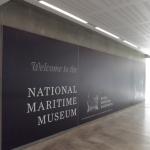The National Maritime Museum, Greenwich
Set in delightful Georgian buildings at Greenwich, the National MaritimeConnected with the sea, especially in relation to seaborne trade or naval matters. Museum (NMM) was established by Act of Parliament in 1934 and opened to the public by King George VI on 27th April 1937. It offers free entry to most exhibits covering several floors (special exhibitions incur a charge, but are included in the big ticket, which covers most of the Greenwich museums). It is worthwhile noting that the Falmouth branch of the museum, which houses nowhere near as many exhibits, costs £12 entry per adult and £8.50 for over 5s. There are also two cafés, a shop, a children’s play area and a ship simulator (which sadly is a modern design, rather than a galleon or other historic vessel).
It is worthwhile noting that the Falmouth branch of the museum, which houses nowhere near as many exhibits, costs £12 entry per adult and £8.50 for over 5s. There are also two cafés, a shop, a children’s play area and a ship simulator (which sadly is a modern design, rather than a galleon or other historic vessel).
Despite the children’s area, this is a museum for older children and adults (unless the younger ones have a particular interest in the sea). There are not many gadgets or activities to entertain the very young, although the exhibitions themselves are interesting. For me, the star was definitely the Nelson exhibition, which contained a surprising array of artefactsObjects made by humans that are of historical interest., including the coat (complete with bullet hole) Nelson was wearing when he was shot, a lock of hair he sent to Emma Hamilton on his deathbed, and the stockings he was wearing – still with blood stains – when he fell in his secretary, Scott’s, blood. Macabre, but fascinating. Other outstanding collections included the original sea clocks designed and made by John Harrison in the pursuit of determining longitude during the late seventeenth and early eighteenth centuries, This was a temporary exhibition and there was an additional charge for entry. and out-of-place finds such as amphorae in Brazil.
This was a temporary exhibition and there was an additional charge for entry. and out-of-place finds such as amphorae in Brazil.
Sadly, not all of the exhibitions were as good, and could seem somewhat biased. For example, the displays on the East India Trading Company almost entirely glossed over the nefarious aims and methods of that business, whilst the information video on the role of the navy during the Napoleonic WarsThe Napoleonic Wars lasted from 1803 until 1815 (although some people also include the French Revolutionary Wars in this, which started in 1792 and continued until 1802. The Napoleonic Wars were therefore a continuation of the Revolutionary Wars). A number of European powers fought against the expansionist French Empire. perhaps succeeded in trotting out the line of the national curriculum, but did nothing to distinguish between ‘good for the government’ and ‘good for the people’. Instead it provided an unhealthy dose of propagandaBiased and misleading information used to promote a political cause or point of view. and left no room for questions. This doesn't compare well with the Falmouth branch of the National Maritime Museum, which during a recent exhibition on piracy, gave a good and unbiased account of ‘free trade’ during the same period.
Despite these issues, the Maritime Museum was a fantastic day out – particularly as it was by and large free – and well worth a visit. Given the quality of items on display, it must be a star attraction, not just for students of maritime history, but also for those with even the slightest interest in the sea.
Find out more about the National Maritime Museum here.
- Log in to post comments







